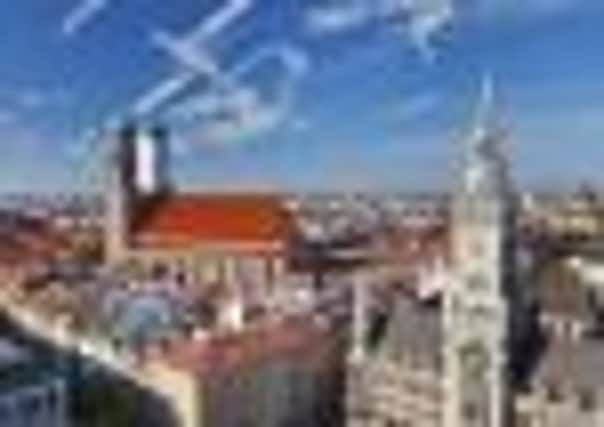Travel: Munich
This article contains affiliate links. We may earn a small commission on items purchased through this article, but that does not affect our editorial judgement.


And it’s because of Wagner that I find myself in this great and proud Bavarian capital after an absence of many years. I’m on the trail of the Rhine gold, attending a performance of Der Ring des Nibelungen at the National Theatre by the Bavarian State Opera as part of the Munich Opera Festival. The work’s a cultural magnet like no other. I just can’t leave it alone.
But Wagner did – for 12 years in fact. During his self-imposed Ring exile he managed to write Tristan und Isolde and Die Meistersinger von Nürnberg. However, when he started on the Ring in 1848 little did he know that he would finish it at his beloved home in Bayreuth, Villa Wahnfried. The exact date was 21 November 1874. The quartet of works comprises Das Rheingold, Die Walküre, Siegfried and Götterdämmerung.
Advertisement
Hide AdHowever, on the insistence of King Ludwig, Wagner’s highly eccentric but very generous patron, special previews of Das Rheingold and Die Walküre were actually given in Munich against Wagner’s wishes – Das Rheingold premiered on 22 September 1869 at the National Theatre with Die Walküre performed on 26 June the following year. As a result stubborn Wagner delayed announcing the completion of Siegfried in order to prevent King Ludwig pulling the same stunt with this part.
The cycle – modelled after ancient Greek dramas that were usually presented as three tragedies and one satyr play – is a work of extraordinary scale and power – and, indeed, length. It takes place over four nights and lasts 16-17 hours. The first and shortest opera is Das Rheingold and the longest, Götterdämmerung. Therefore, the Ring proper begins with Die Walküre and ends with Götterdämmerung with Das Rheingold acting as a prelude. Wagner called Das Rheingold a Vorabend (or Preliminary Evening) and Die Walküre, Siegfried and Götterdämmerung were subtitled First Day, Second Day and Third Day respectively.
I am a veteran of many cycles over the past few years, including, in 2003, Tim Albery’s production for Scottish Opera.
Unfortunately, I won’t make this weekend’s Wagner performance in Edinburgh. Tomorrow the BBC Scottish Symphony Orchestra will showcase Act 1 of Wagner’s Tristan und Isolde at the Usher Hall, with the next two acts following over the course of the season. I’m sorry to miss the BBC SSO chief conductor Donald Runnicles, a noted Wagner conductor, in action.
And acclaimed Swedish soprano Nina Stemme, who takes the role of Isolde for the first two acts alongside English tenor Ian Storey as Tristan, is marvellous, as I saw her as Brünnhilde in Munich.
The current staging at Munich is directed with great imagination and flair by Andreas Kriegenburg, a self-taught director and a carpenter by trade.
Advertisement
Hide AdThe pivotal role of Wotan was shared by Danish bass-baritone Johan Reuter (Das Rheingold) and German bass-baritone Thomas Johannes Mayer (Die Walküre) while American bass-baritone, Alan Held, took the role of Der Wanderer in Siegfried.
The mezzo-soprano Sophie Koch as Fricka, Wotan’s long-suffering wife, was radiant in her role, as was Aga Mikolaj as Freia the goddess of youth, beauty and feminine love, while Stefan Margitaas conjured up some colourful combustible magic as Loge, the god of fire, who eventually returns to his elemental form and destroys everything.
Advertisement
Hide AdWagnerian wonder boy Klaus Florian Vogt and Anja Kampe were exemplary in their brother-and-sister roles of Siegmund and Sieglinde. Her deep sadness matched her brother’s fate while Ain Anger (Hunding), Sieglinde’s suspicious forester husband, played his part to the full – meanto the end.
Canadian heldentenor, Lance Ryan, showed true Wagnerian prowess as Siegfried, acting very boyish one minute and manly the next.
As the curtain fell the audience gave a standing ovation, going even wilder when Munich’s music director Kent Nagano – in the pit for his first fully staged cycle – took his bow.
But Munich has witnessed many great opera occasions. It’s an opera city like no other. Mozart’s Idomeneo was first staged here in January 1781 at the Cuvilliés Theatre, an ornate rococo-designed building by François de Cuvilliés, while Capriccio – the final opera by Munich-born Richard Strauss – received its premiere at the Bayerische Staatsoper National Theatre in 1942.
And my walk to the National Theatre – lovingly designed in the Neo-Classical style – took a leisurely 20 minutes from my hotel situated near the Deutsches Museum. My route took me past the Hofbräuhaus am Platzl, a stone’s throw from Marienplatz, the centre of Munich’s Old Town where the Rathaus’ Glockenspiel chimes and re-enacts two stories from the 16th century every day at 11am (noon and 5pm in summer).
I stayed in modest luxury in Motel One, a new low-budget design hotel that I first came across when I was in Leipzig attending the BachFest. My room – spacious and comfortable – was located on the tenth floor and offered breathtaking panoramic views of the city’s myriad spires, domes and towers, reminding me in so many ways of Canaletto’s famous painting of Dresden from the river Elbe.
Advertisement
Hide AdIn fact, Motel One has positioned itself nicely in Germany as a low-budget brand and is now heading over to the UK. Currently, there are 39 hotels in Germany with a couple in Austria and an Edinburgh opening on Market Street is imminent.
THE FACTS
For more information about the Munich Opera Festival 2013 see www.bayerische.staatsoper.de
Fly to Munich from Edinburgh from around £130, see www.easyjet.com; rooms in Munich start from 59 Euro, see www.motel-one.com